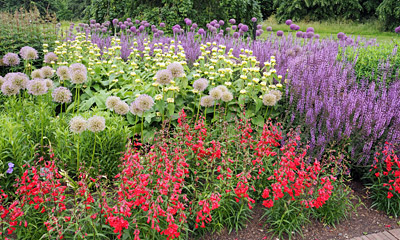June
General Tasks
- Continue sowing biennials.
- Sow perennials and calceolarias, cinerarias and fairy primroses.
- Continue planting out bedding plants.
- Lift and divide bearded irises and primulas after flowering.
- Continue training sweet peas.
- Move chrysanthemums outside.
- Stake tall-growing flowers.
- Propagate pinks from cuttings.
- Cut back or dead head spent flowers.
The Flower Garden in Early Summer
What to do in the flower garden in June
Harden off and plant out any remaining plants that were raised under protection. While early June is usually the end of the planting season in southern England, it can still be in full swing in the north and Scotland.

Provide supports for herbaceous plants and hardy annuals as necessary. Border carnations and other tall stemmed plants often become lanky at this time, especially those with large heavy flowers, so provide suitable support. Often the arching growth is part of the charm of a plant, so don't tie them too tightly to supports, or they will look unnatural.
To encourage large flowers on border perennials, remove any side shoots that form on the stems and remove all but the terminal flower bud.
Where possible, deadhead annuals, to keep fresh supplies of flowers through the summer. If you want them to self-seed, or want to save seed to sow elsewhere in the garden, then stop deadheading towards the end of the season. Deadheading small flowered plants such as lobelia and ageratum are not worth the effort.
Herbaceous perennials that have finished flowering can be cut back now to just above the basal foliage, unless you want the seed for sowing or to leave the seed pods for architectural effect.
What Flower Seeds to Sow in June
Continue sowing biennials, including forget-me-nots and stocks that are required for next spring's bedding. Sow them in rows in the vegetable patch or other dedicated area and make sure that the ground never dries out before the seedlings are growing strongly.
Start sowing perennials now so they can make large enough plants to withstand the winter. You can either buy seed from catalogues and garden centres or you can collect your own seed from plants the garden; or ever better collect from a friend's or neighbour's garden so that you can grow something new.
Perennials with fine seeds are best sown indoors in trays or individual pots. Larger seeded varieties can be sown outdoors in seed drills, remember the smaller the seed, the shallower the drill. Primulas, violas and pansies can also be sown now, too, but at this time of year it is best to provide the seedlings with light shade.
Continue to plant-out tender bedding plants, and half-hardy annuals that have been hardened off, in their final positions.
Lifting Bulbs for Storage
Once spring flowering bulbs have finished flowering they should allowed at least six weeks unhindered growth, before the foliage can safely be cut down and the bulbs lifted for storage.
Although not essential, clumps of naturalised bulbs that have remained in the same place for more than about five years can be lifted and split up. They can either be replanted straight away or dried off and left until the autumn.
Overcrowded bulbs and removal of the foliage too soon after flowering are the main reasons for a reduction in flower displays in subsequent years.
Propagation
June is a good time to increase your stock of plants by taking softwood cuttings. Garden pinks and border carnations can be propagated from cuttings at the end of June and cuttings can still be taken of pelargoniums and fuchsias. For details see our section on Propagation by Cuttings.
Dividing Primroses and Polyanthus
Primrose, polyanthus and old fashioned auricula clumps that have finished flowering can be lifted and divided in June. For details see our section on Propagation by Division.
Dividing Bearded Irises
Tall bearded irises can be divided every four or so once they become overcrowded. Once they have finished flowering, lift the clumps of rhizomes with a fork, then remove and discard the old spent parts of the plant. Select strong growths with at least 10 cm (4 in) long sections of rhizome and cut the leaves back by half. Arrange the rhizomes so that their leaves are all angled in the same direction and then plant them firmly, just barely covering the rhizomes with the soil.
Next Page >> Taking care of the Lawn in June >>
Plants for June
Herbaceous perennials in flower this month:

Achillea

Alchemilla (Lady's Mantle)

Alstroemeria

Anchusa (Alkanet)

Aquilegia (Columbine)

Astilbe

Astrantia (Masterwort)

Campanula (bell flowers)

Centaurea (cornflower)

Coreopsis (tickseed)

Delphinium

Dianthus (pinks)

Digitalis (foxglove)












